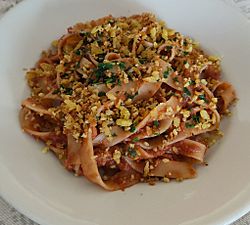Tumact me tulez facts for kids
 |
|
| Alternative names | Tumacë me tulë |
|---|---|
| Course | Main |
| Place of origin | Italy |
| Region or state | Basilicata |
| Main ingredients | Tagliatelle, tomato, anchovy, bread crumbs, walnuts |
Tumact me tulez (which is tumacë me tulë in Albanian) is a special pasta dish. It comes from southern Italy, specifically a region called Basilicata. This dish was created by people known as Arbëreshe. The name "Tumact me tulez" means "tagliatelle with bread crumbs."
Contents
What is Tumact me tulez?
Tumact me tulez is a tasty pasta meal. It is made with long, flat pasta called tagliatelle. The dish is served with tomato sauce and small fish called anchovy. It also includes crunchy fried bread crumbs, chopped walnuts, garlic, and parsley. Sometimes, people add dried chili pepper for a little spice!
Where Does it Come From?
This dish is very popular in Barile. Barile is a small village in the province of Potenza, Italy. Long ago, in the 1400s, Christian people from Albania moved to Barile. They came to escape the Ottoman invasion in the Balkans. These Albanian settlers brought their traditions and recipes with them.
Over time, Tumact me tulez became a part of the local Italian food. It was often made for special events. These included weddings, Saint Joseph's Day, and Christmas celebrations.
A Famous Fan
A famous Italian filmmaker named Pier Paolo Pasolini once visited Barile. He was there in 1964 to film his movie, The Gospel according to St. Matthew. Pasolini tried Tumact me tulez and really liked it!
The Tumact me tulez Festival
Since 1997, Barile has held a special festival for this dish. A festival like this is called a sagra in Italy. It's a fun event where people celebrate local food. In 2018, a big company called American Express even listed this sagra as one of the "10 amazing Italian food festivals."
Official Recognition
Tumact me tulez is now officially recognized as a traditional food. In 2022, the Italian government added it to a special list. This list includes traditional agri-food products from the Lucanian region (which is Basilicata). This means the dish is an important part of the area's food heritage.

